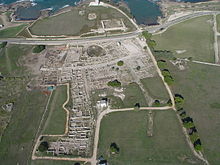Gnathia (city)
Coordinates: 40 ° 53 ' N , 17 ° 23' E

Gnathia , also Egnatia , Ignatia , Gnatia or Egnazia (Italian form) was an ancient port city in the southern Italian region of Apulia near today's Fasano , between Bari and Brindisi on the Adriatic Sea. The place is named for the Gnathia pottery .
history
Gnathia was on the border of the Peuketeer and Messapian settlement areas . In the 4th / 3rd Century BC The town, which had been inhabited since the middle Italian Bronze Age , was expanded to become an urban area. Gnathia experienced its heyday especially during the early Roman Empire, when it was on the Via Minucia , an important road to Brundisium (Brindisi), the ferry port for the crossing to Greece. The poet Horace came in 38 BC. On the journey to Brundisium through Gnathia. At the beginning of the 2nd century AD, Emperor Trajan had the Via Minucia and the coastal road that meets this at Gnathia, from Bari, branches of the Via Appia , expanded as Via Traiana. In late antiquity, Gnathia was the seat of a bishop. The titular bishopric Egnazia Appula of the Roman Catholic Church goes back to the diocese . The city was destroyed by the Ostrogoth king Totila in 545; the inhabitants fled to Monopoli .
The first systematic archaeological excavations in Gnathia took place in 1912/1913; they have continued with interruptions until recently. Remains of the city wall, the Greek agora , the Roman forum , two Christian basilicas and numerous graves are to be mentioned. According to Gnathia, the 4th century BC It was named Gnathia pottery , which was widely used in the middle of the 19th century.
literature
- Felice G. Lo Porto: Gnathia (Egnatia) Apulia, Italy . In: Richard Stillwell et al. a. (Ed.): The Princeton Encyclopedia of Classical Sites. Princeton University Press, Princeton NJ 1976, ISBN 0-691-03542-3 .
- Gerhard Radke : Gnathia. In: The Little Pauly (KlP). Volume 2, Stuttgart 1967, column 822.
- Holger Saturday : Gnathia. In: The New Pauly (DNP). Volume 4, Metzler, Stuttgart 1998, ISBN 3-476-01474-6 , Sp. 1106.
Web links
Remarks
- ^ In summary, Marco Bettelli: Italia meridionale e mondo miceneo. Ricerche su dinamiche di acculturazione e aspetti archeologici, con particolare riferimento ai versanti adriatico e ionico della penisola italiana. Florence 2002, p. 24 (with further literature).
- ↑ Strabon 6, 3, 7 ( English translation ).
- ↑ Horace, Satires 1, 5 , 97-103.

